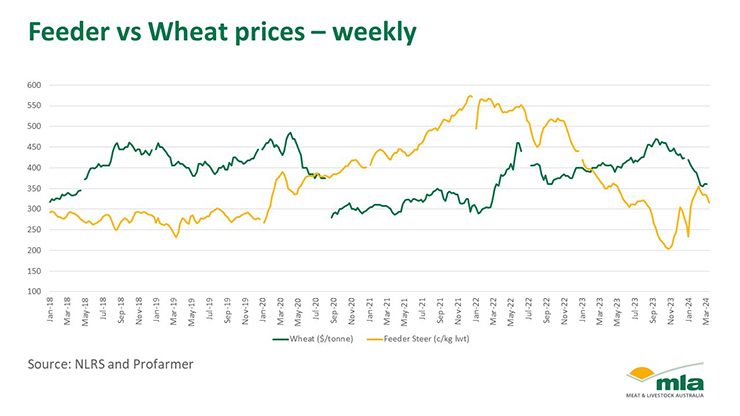Grain price dip boosts lot feeder margins
14 March 2024
Key points:
- Current feed wheat and feeder steer prices provide a strong opportunity for lot feeders.
- Darling Downs Wheat prices have eased to 360 $/tonne, the lowest price since March 2022.
- The feeder steer prices 316 c/kg lwt, backing off since the recovery seen at the beginning of the year.
Grain prices have continued to ease through the start of 2024, further improving lot feeder margins and building confidence in the sector.
The Australian lot-feeding industry has experienced consistent and positive growth, supported by infrastructure, export markets and domestic supply.
The Australian Lot Feeders Association recently released the results of their quarterly survey, indicating record levels of feedlot capacity and numbers on feed. Quarter 4 showed 1.3 million head on feed, alongside a fifth consecutive increase in capacity to a record 1.6 million head.
This growth, partly fuelled by smaller lot feeders re-entering the sector, reflects the positive sentiment within the sector.
Feed wheat and feeder steer prices
Feeder cattle and feed grain prices exhibit a strong inverse relationship, influenced by climatic conditions impacting the supply of both commodities, as well as the cattle and grain being the largest inputs for lot feeders.

In September/October last year, we witnessed the peak of this inverse relationship. Wheat prices rose to $463/tonne, and feeder steer prices were 211¢/kg live weight (lwt), marking the lowest nominal price since 2011. This dynamic mirrored the maturation of the national herd rebuild, increased cattle supply, and a poor harvest outlook for southeast Queensland, northern NSW, and parts of WA’s Wheatbelt.
Longer-term trends show a narrowing of this gap. Wheat prices have eased to $360/tonne, down 22% from last year's peak, and feeder steer prices have slightly rebounded to 316¢/kg lwt, marking a 53% increase from last year’s bottom prices. This reflects the market dynamics observed towards the tail end of 2020, following post-drought livestock market recoveries and an increase in feed grain supply due to a break in the drought.
More recently, weekly wheat prices have remained low, while the feeder steer prices have continued to ease week-on-week. Reductions in the two major cost inputs for feedlots present a lucrative opportunity for the sector, supporting strong profit margins. Lot feeders will be closely monitoring this relationship.
Looking ahead, if feed wheat prices continue on this downward trend, we anticipate an impact on next quarter's turn-off numbers. Lot feeders are likely to seize this opportunity to participate in longer fed programs and monitor heavy steer prices, seeking premiums for the extra investment in weight.


